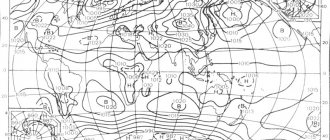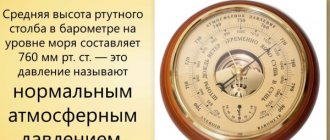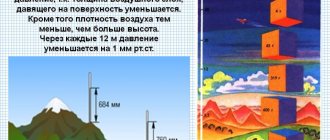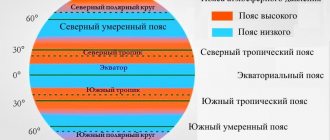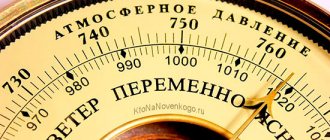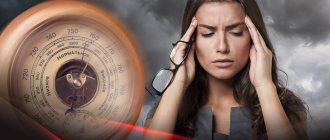Nobody likes to be under pressure. And it doesn’t matter which one. Queen also sang about this together with David Bowie in their famous single “Under pressure.” What is pressure? How to understand pressure? How is it measured, by what instruments and methods, where is it directed and what does it press on? The answers to these and other questions are in our article about pressure in physics and not only.
Exact sciences
The unit of measurement of pressure in physics and chemistry is the letter “P” (translated into Latin as “pressūra”). If there is equilibrium inside and outside the cylinder walls, the indicator is designated “P”. The international system uses Pascals. Using the formula for fluid pressure and force, we can come to the conclusion that 1 Pa = 1 N/ 1 sq. m. Since the unit is small, it is difficult to use in calculations.
From the table of standard converters in physics, the following notations are more often used:
- Bars. 1 Bar=105 Pa.
- Torrs or mmHg (1 torr equals 133 Pa).
- mm water pillar
To determine pressure, force and area are used: P = mg / S. There is a dependence of the value on volume and mass. The indicator is characterized by the following property: the smaller the area, the greater the force exerted on the body. If the pressure does not change, but S increases, then the desired indicator decreases.
General formula for pressure (7th grade physics)
From the definition of a given physical quantity, one can determine the method for finding it. It looks like in the photo below.
In it, F is force and S is area. In other words, the formula for finding pressure is its force divided by the surface area on which it acts.
It can also be written as follows: P = mg / S or P = pVg / S. Thus, this physical quantity turns out to be related to other thermodynamic variables: volume and mass.
For pressure, the following principle applies: the smaller the space that is affected by the force, the greater the amount of pressing force that falls on it. If the area increases (with the same force), the desired value decreases.
Main formulas
When the conditions of the state of aggregation of a substance change, properties that differ from each other are observed. Taking this principle into account, the method for calculating P is determined. For the hydrostatic state, the formula is used: P = pgh, where:
- p—density;
- g—acceleration;
- h - height.
Hydrostatics applies to gases. The exception is the calculation of blood pressure. This is explained by the difference in heights and densities of air masses. The P value of a substance depends on the depth of immersion of an object or object. Since the force F is calculated by multiplying m by g, and the mass of water by p by V, the ideal option for calculating pressure is the following expression: P = pVg / S. The formula is used on online resources where you can solve problems in physics and chemistry.
If the area is written in the form S= V/h, then P= pgh. The pressure in water or other liquid is calculated taking into account changes in the upper layer. This leads to the formation of another R. To find the absolute force, the formula is used:
P = P0 + 2QH, where:
- P0 is the pressure of the unchangeable layer;
- Q is the surface of tension of the liquid substance;
- H is the average value.
The latter figure must be reported between the first two, so it is considered an average. To determine the value, the radii of curvature are used: ½ (1/R1+ 1/R2). Each type of gas exerts a specific partial pressure. The ideal state is characterized by the sum P of each individual component of the mixture. A common mistake that schoolchildren make when calculating air pressure is using only oxygen. But air is presented in the form of various gases:
- argon;
- nitrogen.
To find the pressure of air masses, use the formula P=P1+P2+P3…
Partial pressure and its formula
Although the P = pgh method is applicable for both liquids and gases, it is better to calculate the pressure in the latter in a slightly different way.
The fact is that in nature, as a rule, absolutely pure substances are not very often found, because mixtures predominate in it. And this applies not only to liquids, but also to gases. And as you know, each of these components exerts a different pressure, called partial.
It's quite easy to define. It is equal to the sum of the pressure of each component of the mixture under consideration (ideal gas).
It follows from this that the partial pressure formula looks like this: P = P1+ P2+ P3... and so on, according to the number of constituent components.
There are often cases when it is necessary to determine air pressure. However, some people mistakenly carry out calculations only with oxygen according to the scheme P = pgh. But air is a mixture of different gases. It contains nitrogen, argon, oxygen and other substances. Based on the current situation, the air pressure formula is the sum of the pressures of all its components. This means that we should take the above-mentioned P = P1+ P2+ P3...
Types of quantities
The pressure can be different (excessive, barometric). The absolute concept is characteristic of a substance or object that is not affected by other gases. The indicator is measured in Pascals. It is calculated using the following calculator: normal P = P2 + P3 or P = P2 - P4.
The starting point comes from the planet Earth, the force inside the vessel from which the air has been removed. The quantity is used in many thermodynamic formulas. To define gravity, the concept of barometric or atmospheric pressure is used. It changes taking into account the temperature of the atmosphere, time, altitude.
Normally, the indicator is 760 mmHg. Art., and the temperature should correspond to zero Celsius. The higher an object is from the Earth, the lower the pressure on it. The value decreases by 100 Pa every eighth kilometer.
In the mountains, water boils faster than at home: pressure affects the boiling point. If it decreases, t decreases. The dependence also remains in reverse order. Some kitchen appliances operate on a similar property: pressure cooker, autoclave. As the nominal P rises, the temperature inside rises.
For calculations, a standard formula is used where variables are used:
- density of air masses near Earth level;
- height;
- acceleration;
- temperature;
- molar mass.
If the number of particles is specified in moles, a formula with a constant value of K is used. When carrying out calculations, the probability of temperature changes is taken into account, which is associated with changes in weather, elevation gain, and geographic latitude. If the measured value is subtracted from the atmospheric P, the excess force is obtained. Taking into account the result, the name of the indicator changes:
- positive - manometric;
- negative - vacuum.
The last value cannot exceed the barometric level. The difference in pressure at different points is called a differential phenomenon. It is used to determine P on certain equipment. This concept is used in the oil industry.
Atmosphere pressure
The atmosphere is a gas, or more precisely, a mixture of gases, which is held near the Earth due to gravity. The atmosphere passes into interplanetary space gradually, and its height is approximately 100 kilometers.
How do we understand the expression “atmospheric pressure”? Above every square meter of the earth's surface there is a hundred-kilometer column of gas. Of course, the air is clear and pleasant, but it has a mass that presses on the surface of the earth. This is atmospheric pressure.
Normal atmospheric pressure is considered to be 101325 Pa. This is the pressure at sea level at 0 degrees Celsius. 766 high exerts the same pressure at the same temperature on its base .
The higher the altitude, the lower the atmospheric pressure. For example, at the top of Mount Chomolungma it is only one-fourth of normal atmospheric pressure.
Everest. At its top the pressure is 4 times less than at the foot
Problem solving
In physics problems, pressure formulas may look different. Task one: you need to find the P exerted by the body on the ship and the ground under water when the diver is in motion. A person weighs 180 kg with equipment on land. The area of the foot is 360 square meters. cm. The force with which a person acts on the ship is 180/360 = 0.5 (kgf/cm). Using the table, the value can be converted to Pa. The result is 49 kPa. A force of 2.46 kPa is exerted on the ground under water.
Example 2: you need to calculate the absolute P of water if the depth is 150 m, the force is 765, and the body weight is 1.024 kgf/l. Solution: P = 765/735.6+1.024×150/10=16.4.
Example 3: the capacity of the cylinder is 40 l, the pressure in it is 150 kgf/cm2. We need to find V free air masses. Solution: initial P is calculated as follows: 150+1 = 151 kgf/sq.cm. The initial V is 40 liters. Free V is calculated p1xstart V/p2=6.04 cubic meters. m. In a similar way, problems are solved where you need to find P of any liquid, solid object, or gaseous substance.
How to reduce or increase blood pressure
A heavy crawler tractor produces a soil pressure of 40–50 kPa. A boy weighing 45 kg produces pressure only 3 times less than such a tractor. This is due to the large area of the tractor tracks.
Depending on the pressure they want to achieve, the area of the supports is reduced or increased. For example, in order to reduce the pressure of a building on the ground, during the construction process the area of the lower part of the foundation is increased.
Truck tires are much wider than passenger car tires. To verify this, pay attention to the wheels of some large truck. The widest tires can be seen on cars designed for driving in the desert. The same life hack is used in aircraft landing gear.
The inverse relationship is also used, for example, when creating blades for piercing and cutting tools. The sharp blade has a small area, so even a small pressure creates a lot of pressure.
Problem once
The book is on the table. The mass of the book is 0.6 kg. The area of its contact with the table is 0.08 m2. Determine the pressure of the book on the table.
Solution
A force equal to the weight of the book will press on the table. Since it is at rest, its weight will be equal to the force of gravity. Hence:
p = mg/S = 0.6 × 10 / 0.08 = 75 Pa
Answer: the pressure of the book on the table will be 75 Pa.
Problem two
The DT-75M tracked tractor weighing 6,610 kg has a supporting area of both tracks of 1.4 m2. Determine the pressure of this tractor on the soil.
Solution:
p = mg/S = 6,610 × 10 / 1.4 = 47,214 Pa = 47.2 kPa
Answer: the tractor pressure on the soil is 47.2 kPa.
Problem three
A man weighing 80 kg with a bag weighing 100 N stands motionless on the floor. The force of pressure of the soles of his shoes on the floor is uniformly distributed over an area of 600 cm2. How much pressure does the person exert on the floor?
Solution
Human mass: m = 80 kg.
Weight of the bag held by a person: Pc = 100 N.
Contact area of the sole of the boots with the floor: S = 600 cm2.
600 cm2 = 600 / 10,000 m2 = 0.06 m2
Pressure is the ratio of force to the area over which it acts. In this case, the force acting on the area is equal to the sum of the person’s gravity and the weight of the bag:
F = mg + Pс
Therefore, the pressure exerted by a person with a bag on the floor is equal to:
p = (mg + Pc) / S = (80 × 10 + 100) / 0.06 = 15,000 Pa = 15 kPa
Answer: the pressure of a person with a bag on the floor is 15 kPa.
There is even more interesting practice in the elective course in physics for grade 10.
Measuring instruments
You can save time on calculations by using special devices that operate by determining the pressure in the corresponding environment, which is similar to a pressure gauge. Their differences lie in the operating instructions, scope of use, accuracy, and scope.
To determine blood pressure, you will need a barometer-type pressure gauge. To determine the vacuum (Pa less than atmospheric) you will need a different type of apparatus - a vacuum gauge. In humans, the indicator is determined using a sphygmomanometer. Most patients call this equipment a non-invasive blood pressure monitor.
Such devices are classified into the following subtypes:
- mercury mechanical;
- semi-automatic;
- automatic digital.
Their accuracy depends on the materials used in the manufacturing process and the measurement area. Some devices measure blood pressure and pulse simultaneously. They operate automatically from batteries. Due to the presence of a digital display, it is easy to find out the result. Mechanical ones are considered more accurate.
To determine P, you will need to put a cuff on the patient’s right arm. By holding the mechanism, the bulb is pumped. The maximum and minimum limits begin with the appearance and then the disappearance of a characteristic knocking sound. Gradually the mechanism weakens. To obtain accurate data, experience with a mechanical tonometer and attentiveness will be required. If pressure fluctuations in the air are observed, you will need a differential pressure gauge or pressure gauge.
Installation of a storage tank
In areas where there is no centralized water supply, people are accustomed to taking water from wells or boreholes for domestic needs. To get drinking liquid from the depths, you need to use a pump. But every time you need only one cup of water, turning on the pump becomes unprofitable.
Therefore, it is advisable to install the storage tank at a certain height. According to SNiP, as well as Government Decree No. 354, the minimum water pressure at the outlet of the tap should be 0.3 at. And to do this, it is enough to raise the tank only 3 meters. You don't even need to build a tower for this. It is enough to use the attic space of a one-story house.
Once at a certain time, the tank is filled using a pump. The water then moves through the pipes by gravity, according to Pascal's hydrostatic law. And at the outlet of the tap, sufficient pressure will be created to satisfy all household needs.
In addition to wiring from the storage tank to the washbasins and toilet, it is necessary to perform one more mandatory action. Regardless of whether the attic is warm or not, the liquid container must be additionally well insulated. This will guarantee that if frosts intensify in winter, the house will not be left without water.
Water storage tank in the attic Source biiom.ru
Briefly about the main thing
Knowledge of the school physics curriculum can make life much easier and save money. If you use Pascal's law of hydrostatics, you can set up a system in which water will flow to the desired point by gravity. Moreover, this could be either a washbasin in the house or a vegetable bed in the garden.
To do this, you will need to install a container of suitable volume at the desired height. And to determine the latter, you need to use a special formula that determines the pressure of the water column in the system. And all the work will be done by ordinary gravity.
Ratings 0
Consequences of blood pressure disorders
Functional disorders of the heart, kidneys, excess weight, stress, smoking, endocrine and systemic diseases, and atherosclerotic changes in blood vessels lead to a prolonged increase in blood pressure levels. For most people, initial deviations do not cause alarm, but are dangerous for the body. Progressive hypertension is fraught with the development of coronary artery disease, myocardial infarction, and acute cerebrovascular accident.
Regular hypotension - readings below 85/60 lead to insufficient oxygen and nutrition to the tissues. This pathology often occurs due to heart failure, physical exhaustion, and genetic predisposition. Without correction, it can provoke disruption of the central nervous system, hormonal balance, anemia and myocardiopathy.
Changes in blood pressure by age
It is a mistake to think that blood pressure control is only necessary for older people. Diseases associated with its violation can develop at any age. In order not to miss them, it is recommended to monitor blood pressure levels regularly from the first years of life. At the same time, it is important to remember that its standards are different for children and adults. Their range:
- in newborns: from 75/50 to 105/75
- aged 1–5 years: from 80/55 to 110/79
- for 6–15 year olds: from 90/60 to 110/80
- for 16–24 years old: from 110/70 to 132/80
- for 25–39 years: from 110/70 to 135/86
- for 40–59 years: from 111/78 to 139/88
- for 60 years and older: from 116/80 to 147/90
Low rates in infants and children under 1 year of age are explained by imperfections in the vascular system. Their arteries are not elastic enough, and the network of capillaries is dense. As you grow older, the body's tone increases, and the range of blood pressure fluctuations becomes smaller. In children over 5 years of age, blood pressure increases more slowly, reaching the lower limit of the adult normal range by adolescence.
During school years, due to sharp jumps in growth and development, more frequent changes in indicators are possible, including throughout the day. If the condition is not accompanied by poor health, there is no need to worry. An increase of 20 mm or more should cause alarm. In these cases, correction of the daily routine and consultation with a therapist, endocrinologist and cardiologist are required.
Another category of people in whom significant changes in blood pressure are considered normal are pregnant women. Changes in hormonal levels and increased workload inevitably affect the functioning of blood vessels and internal organs. During this period, indicators should be monitored regularly. Their departure from the age norm is a reason for additional consultations with a doctor.

